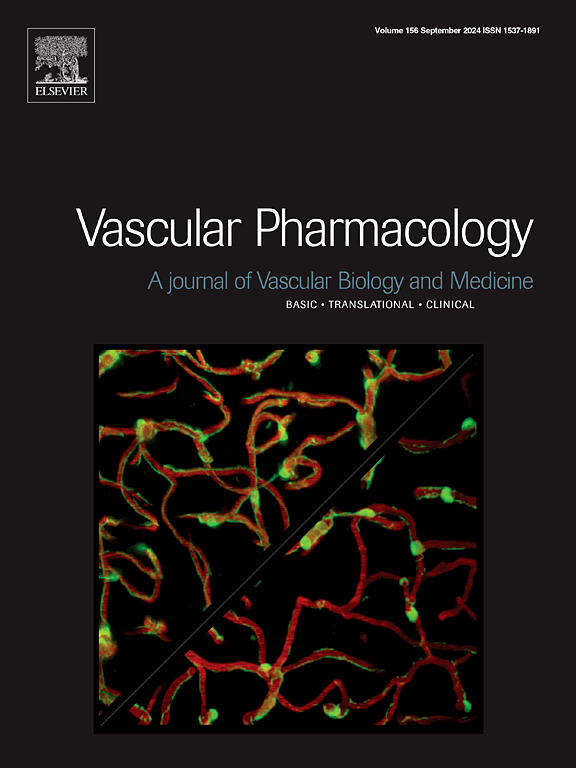epsin在动脉粥样硬化中的作用:从分子机制到治疗应用。
IF 3.5
3区 医学
Q2 PHARMACOLOGY & PHARMACY
引用次数: 0
摘要
动脉粥样硬化是一种以慢性炎症和血管重构为特征的多方面疾病,可导致斑块形成和心血管并发症。最近的证据强调了epsin(一个内吞蛋白家族)在动脉粥样硬化发病机制中的关键作用。本文探讨了epsin在动脉粥样硬化中的多种功能,重点是它们参与血管生成、淋巴管生成和关键信号通路的调节。我们讨论了ep蛋白酶如何通过与TGFβ信号通路的相互作用促进EndoMT,这有助于血管平滑肌细胞样表型和斑块不稳定性。此外,我们研究了靶向epins的治疗潜力,阐明了它们与LDLR、LRP-1和TLR 2/4等关键伙伴在介导脂质代谢和炎症中的相互作用。此外,我们强调了epsin靶向肽和小干扰rna作为动脉粥样硬化治疗药物的前景。尽管取得了这些进展,但研究仍面临局限性,包括依赖于特定的小鼠模型,以及需要对epsin调节的长期影响进行全面的研究。因此,未来的研究应侧重于阐明epsin功能的详细机制及其在心血管健康中的意义,促进合作,将基础研究转化为创新的治疗策略。这项工作强调了进一步探索epsin的必要性,以释放其在对抗动脉粥样硬化和相关心血管疾病方面的全部治疗潜力。本文章由计算机程序翻译,如有差异,请以英文原文为准。

The role of Epsins in atherosclerosis: From molecular mechanisms to therapeutic applications
Atherosclerosis is a multifaceted disease characterised by chronic inflammation and vascular remodelling, leading to plaque formation and cardiovascular complications. Recent evidence highlights the critical role of epsins, a family of endocytic proteins, in the pathogenesis of atherosclerosis. This manuscript explores the multifarious functions of epsins in atherosclerosis, focusing on their involvement in angiogenesis, lymphangiogenesis, and the modulation of key signalling pathways. We discuss how epsins facilitate EndoMT through their interaction with the TGFβ signalling pathway, which contributes to vascular smooth muscle cell-like phenotypes and plaque instability. Additionally, we examine the therapeutic potential of targeting epsins, elucidating their interactions with crucial partners such as LDLR, LRP-1, and TLR 2/4, among others, in mediating lipid metabolism and inflammation. Furthermore, we highlight the promising prospects of epsin-targeting peptides and small interfering RNAs as therapeutic agents for atherosclerosis treatment. Despite these advancements, the research faces limitations, including a reliance on specific mouse models and a need for comprehensive studies on the long-term effects of epsin modulation. Therefore, future investigations should focus on elucidating the detailed mechanisms of epsin function and their implications in cardiovascular health, fostering collaborations to translate basic research into innovative therapeutic strategies. This work underscores the necessity for further exploration of epsins to unlock their full therapeutic potential in combating atherosclerosis and related cardiovascular diseases.
求助全文
通过发布文献求助,成功后即可免费获取论文全文。
去求助
来源期刊

Vascular pharmacology
医学-药学
CiteScore
6.60
自引率
2.50%
发文量
153
审稿时长
31 days
期刊介绍:
Vascular Pharmacology publishes papers, which contains results of all aspects of biology and pharmacology of the vascular system.
Papers are encouraged in basic, translational and clinical aspects of Vascular Biology and Pharmacology, utilizing approaches ranging from molecular biology to integrative physiology. All papers are in English.
The Journal publishes review articles which include vascular aspects of thrombosis, inflammation, cell signalling, atherosclerosis, and lipid metabolism.
 求助内容:
求助内容: 应助结果提醒方式:
应助结果提醒方式:


